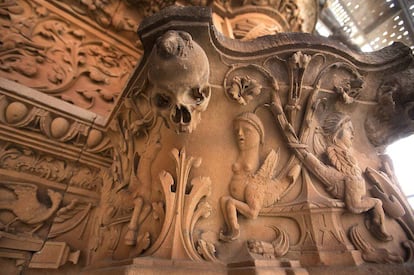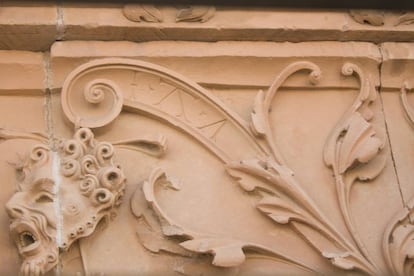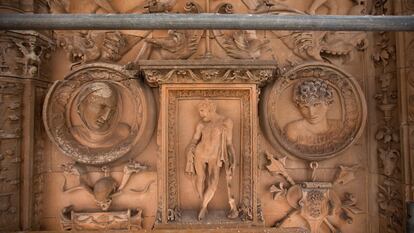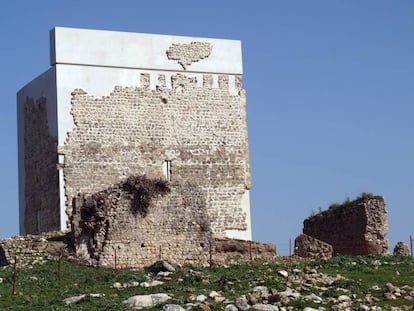What mysteries lie behind Salamanca university’s famous facade?
Damage caused by rain, wind and pigeons has complicated restoration of iconic building

Looking up at the forest of sculptures on the famous facade of the University of Salamanca’s Escuelas Mayores building, visitors are hard pressed to identify the various historical figures on display. Is that a pope, or is it Charles V or even Julius Caesar? And would that be Hercules, Venus, or Jupiter? All are embedded within the rich tapestry of carvings that covers the outside of Europe’s third-oldest university, and which includes details such as cheekbones, teeth and hair chiseled painstakingly into each individual character.
One of the biggest challenges for both visitors and students is to spot the famous frog among this forest of faces – the highbrow equivalent to Where’s Wally? Failure to pinpoint the elusive creature traditionally meant that medical students would fail to graduate.
The facade is possibly the best example there is of Plateresque (or silversmith-like) architecture peculiar to Spain and its territories during the early Renaissance period, and the university’s upcoming 800th anniversary in 2018 has prompted a restoration project that will be completed by the end of November after four months of demanding work.
Among the surprising findings is the existence of two pieces of 18th-century graffiti
Architect Jesús Castillo Oli, director of the Santa María Foundation Heritage Conservation department and the figure responsible for the restoration, explains that although the facade was in decent shape, the elements have taken an inevitable toll on the sculptures and more than 50 people have been involved in restoring them, using funds donated by the regional government of Castile and Leon (€220,000), the University itself (€220,000) and Salamanca-based energy company, Enusa (€125,000).
Castillo points out that the intricacy of the sculptures complicates the job of eliminating blemishes such as the black stains that have appeared on the pink stone. In order to avoid further deterioration, the cleanup process calls for the gentlest of techniques. “Afterwards, if the sillar stone is crumbling, it is strengthened and toned to bring out the color,” he explains.

One of the most surprising findings since the restoration work began late summer is the inscription “Espedición 1853”. That year a teacher and his students from the recently created Madrid Architecture School clambered up scaffolding and one graffiti artist left his trace – twice.
Several meters below, Castillo touches the lichen that puts down roots in the stone, then he mentions the damaging acidity of pigeon waste. Up close, the damage is all too obvious. “Considering how extraordinary the sculptures are, there are aspects at the top that have been poorly structured architecturally speaking – stones that are out of line,” says Castillo. “You can see that when they were brought from the workshop, they didn’t fit the space allowed for them.”
The sketchy alignment isn’t the only puzzle surrounding the facade. Salamanca lecturer, Eduardo Azofra, is familiar with the enigmas attached to this triumph of horror vacui – the practice of filling the entire surface of an artwork with detail. “We don’t know the exact date of its construction because all the university archives from this period have been lost,” he says. “But the facade doesn’t date back to before 1512 and it was probably finished by 1529. In one document dated 1528, architect Juan de Álava speaks about the library that lies behind what was called “la portada rica” – or the ornate entrance.
Azofra says the biggest question is who was responsible for the building of a facade with so many cultural references, clearly designed for a highly learned audience. Several historical characters have been mooted, such as Joanna of Castile, the Mad. “There’s a book from 1666 in the University that states she paid for the facade, though it’s the only document to do so,” he says.

Another massive question mark hangs over who actually carried out the work. During the period in question, there were a number of prestigious architects in Salamanca due to the construction of the new cathedral. But historian Alicia M. Canto points to the existence of the initials I.T.A. on the facade as evidence that the architect Juan Talavera was behind the project.
No other building in the city bears these initials but Talavera was closely linked to Joanna the Mad.
Whoever was behind the project, they factored in a 30cm tilt from the base to the top to give a better view of the whole facade from the ground. And besides the main architect, there would, as Azofra suggests, have been various sculptors involved.“The style of each of the three horizontal bodies is completely different,” he says.
The quality of the uppermost body led historian Martín González to suggest the sculptor was Alonso Berruguete. Meanwhile, a certain uniformity prevails in some of the panels that were inspired by Italian engravings.
Interpreting the sculpted figures is a complex business. Theories from historians during the 1970s suggested that the facade was divided, like a renaissance palace, into two halves with one half representing virtue and the other, vice. However, French historian Paulette Gabaudan believes it was built as a tribute during the reign of Charles V. Art history expert, Felipe Pereda took this idea further, suggesting it was actually a tool for the instruction of Charles V, with historical and mythological references which would be key to both his education and his successful rule.
Looking for the famous frog on the facade is a highbrow version of ‘Where’s Wally?’
The latest theory maintains that the facade represented the idea that Charles, as the emperor of the Holy Roman Empire had been called to follow the four great empires of the earth, namely Babylon, Greece, Carthage and Rome. “There was both political and religious intent in the fashioning of the facade,” says Azofra. “The university is indebted to both the monarchy and the papacy.”
But what about the frog? A tourist attraction, the source of legend and perhaps a warning against lust, the frog upset local novelist Miguel de Unamuno, who is thought to have said: “It’s not that they see vice in the frog, it’s just that the frog is all they see.” This is substantiated by a scratch on a photo of the facade prior to its restoration at the university entrance, marking the location of the famous amphibian.
English version by Heather Galloway.
“Thick round books”
Salamanca University's facade was added decades after the main building was constructed. Between the facade and the main building lies the manuscript room that houses a medieval prayer book from the 11th century belonging to Queen Sancha of León. The university owns 3,000 manuscripts, 487 incunables – books written before 1501 within Europe – and 60,000 volumes dated between 1501 and 1830, according to the library director, Margarita Becedas. Some of the manuscripts are kept in closets whose doors depict classes during the 18th century with students missing class or passing notes all part of the scene.
The library also has two enormous globes, one of earth and the other of heaven that the writer and mathematician Diego de Torres Villarroel asked the teaching staff to buy in the 18th century. Becedas explains how De Torres used two arguments to persuade the university’s upper echelons to authorize the purchase of what he called “thick and round books.” He said all Christian universities had them, and they would increase the grandeur of the room.
Tu suscripción se está usando en otro dispositivo
¿Quieres añadir otro usuario a tu suscripción?
Si continúas leyendo en este dispositivo, no se podrá leer en el otro.
FlechaTu suscripción se está usando en otro dispositivo y solo puedes acceder a EL PAÍS desde un dispositivo a la vez.
Si quieres compartir tu cuenta, cambia tu suscripción a la modalidad Premium, así podrás añadir otro usuario. Cada uno accederá con su propia cuenta de email, lo que os permitirá personalizar vuestra experiencia en EL PAÍS.
¿Tienes una suscripción de empresa? Accede aquí para contratar más cuentas.
En el caso de no saber quién está usando tu cuenta, te recomendamos cambiar tu contraseña aquí.
Si decides continuar compartiendo tu cuenta, este mensaje se mostrará en tu dispositivo y en el de la otra persona que está usando tu cuenta de forma indefinida, afectando a tu experiencia de lectura. Puedes consultar aquí los términos y condiciones de la suscripción digital.
More information
Últimas noticias
Maduro pleads not guilty before the federal court in New York: ‘I am still the president of Venezuela’
A new test can detect Alzheimer’s from a finger prick
UN team enters Sudanese city of El Fasher after paramilitary massacre: ‘It’s like a ghost town’
A recipe for resistance: Indigenous peoples politicize their struggles from the kitchen
Most viewed
- Gilles Lipovetsky: ‘If you want to live better and fall in love, take Prozac, don’t look to philosophy’
- Alain Aspect, Nobel laureate in physics: ‘Einstein was so smart that he would have had to recognize quantum entanglement’
- Alvin Hellerstein, a 92-year-old judge appointed by Bill Clinton, to preside over Maduro’s trial in New York
- Why oil has been at the center of Venezuela-US conflicts for decades
- Maduro’s downfall puts China’s relationship with Venezuela to the test











































